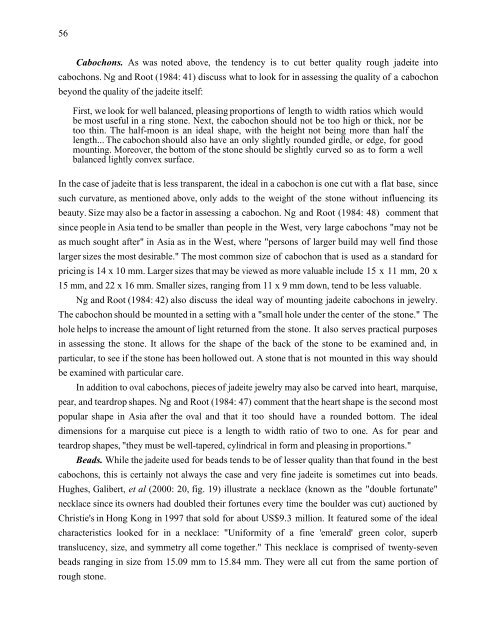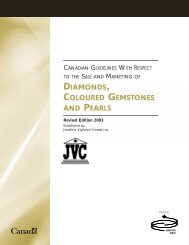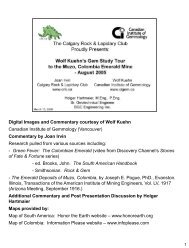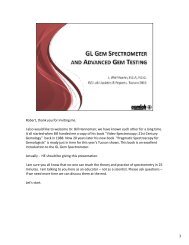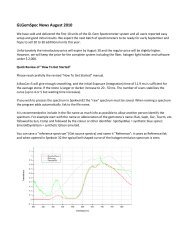JADEITE - Canadian Institute of Gemmology
JADEITE - Canadian Institute of Gemmology
JADEITE - Canadian Institute of Gemmology
You also want an ePaper? Increase the reach of your titles
YUMPU automatically turns print PDFs into web optimized ePapers that Google loves.
56<br />
Cabochons. As was noted above, the tendency is to cut better quality rough jadeite into<br />
cabochons. Ng and Root (1984: 41) discuss what to look for in assessing the quality <strong>of</strong> a cabochon<br />
beyond the quality <strong>of</strong> the jadeite itself:<br />
First, we look for well balanced, pleasing proportions <strong>of</strong> length to width ratios which would<br />
be most useful in a ring stone. Next, the cabochon should not be too high or thick, nor be<br />
too thin. The half-moon is an ideal shape, with the height not being more than half the<br />
length... The cabochon should also have an only slightly rounded girdle, or edge, for good<br />
mounting. Moreover, the bottom <strong>of</strong> the stone should be slightly curved so as to form a well<br />
balanced lightly convex surface.<br />
In the case <strong>of</strong> jadeite that is less transparent, the ideal in a cabochon is one cut with a flat base, since<br />
such curvature, as mentioned above, only adds to the weight <strong>of</strong> the stone without influencing its<br />
beauty. Size may also be a factor in assessing a cabochon. Ng and Root (1984: 48) comment that<br />
since people in Asia tend to be smaller than people in the West, very large cabochons "may not be<br />
as much sought after" in Asia as in the West, where "persons <strong>of</strong> larger build may well find those<br />
larger sizes the most desirable." The most common size <strong>of</strong> cabochon that is used as a standard for<br />
pricing is 14 x 10 mm. Larger sizes that may be viewed as more valuable include 15 x 11 mm, 20 x<br />
15 mm, and 22 x 16 mm. Smaller sizes, ranging from 11 x 9 mm down, tend to be less valuable.<br />
Ng and Root (1984: 42) also discuss the ideal way <strong>of</strong> mounting jadeite cabochons in jewelry.<br />
The cabochon should be mounted in a setting with a "small hole under the center <strong>of</strong> the stone." The<br />
hole helps to increase the amount <strong>of</strong> light returned from the stone. It also serves practical purposes<br />
in assessing the stone. It allows for the shape <strong>of</strong> the back <strong>of</strong> the stone to be examined and, in<br />
particular, to see if the stone has been hollowed out. A stone that is not mounted in this way should<br />
be examined with particular care.<br />
In addition to oval cabochons, pieces <strong>of</strong> jadeite jewelry may also be carved into heart, marquise,<br />
pear, and teardrop shapes. Ng and Root (1984: 47) comment that the heart shape is the second most<br />
popular shape in Asia after the oval and that it too should have a rounded bottom. The ideal<br />
dimensions for a marquise cut piece is a length to width ratio <strong>of</strong> two to one. As for pear and<br />
teardrop shapes, "they must be well-tapered, cylindrical in form and pleasing in proportions."<br />
Beads. While the jadeite used for beads tends to be <strong>of</strong> lesser quality than that found in the best<br />
cabochons, this is certainly not always the case and very fine jadeite is sometimes cut into beads.<br />
Hughes, Galibert, et al (2000: 20, fig. 19) illustrate a necklace (known as the "double fortunate"<br />
necklace since its owners had doubled their fortunes every time the boulder was cut) auctioned by<br />
Christie's in Hong Kong in 1997 that sold for about US$9.3 million. It featured some <strong>of</strong> the ideal<br />
characteristics looked for in a necklace: "Uniformity <strong>of</strong> a fine 'emerald' green color, superb<br />
translucency, size, and symmetry all come together." This necklace is comprised <strong>of</strong> twenty-seven<br />
beads ranging in size from 15.09 mm to 15.84 mm. They were all cut from the same portion <strong>of</strong><br />
rough stone.


